
 |
|
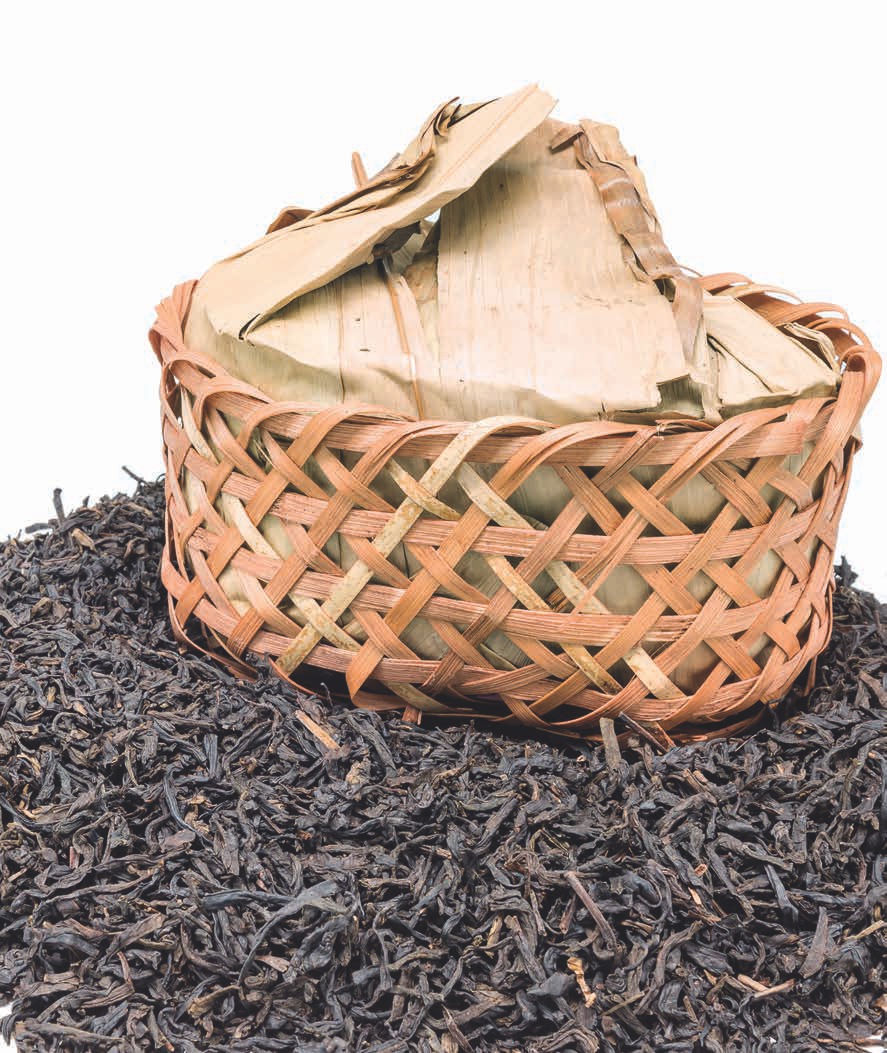
Over the course of this wonderful issue, we are going to be delving into the rich and mysterious world of Liu An black tea. This wonderful tea is little known in the tea world, let alone the West. And since some of us will be heading to Anhui for this year's Global Tea Hut trip, we thought we'd publish an issue on one of the magical teas from that province. There is a lot of interesting history and lore surrounding this tea, but our discussion will begin, of course, with the processing, which is unlike that of any other tea. And no in-depth discussion of Liu An tea would be complete without some of this golden black tea to sip as we talk, so put on the kettle and let's pour some cups of this month's tea, diving right in to the little bamboo basket of Liu An.
During the early years of the Republic, Liu An basket tea had an established place at the tea tables of Chinese people. However, due to the period of war and unrest that followed, and the changing tides of history, Liu An tea was almost unheard of for many years - it very nearly vanished altogether. The process of making Liu An basket tea is complex and timeconsuming; from picking the fresh leaves right through to packing the final product in baskets, the whole process takes more than half a year. The beginning and end of the processing cycle are marked by two particular solar terms, which are units of time Chinese farmers traditionally used to measure the seasons. The picking season begins around Guyu (穀雨) or "Grain Rain," the sixth solar term, which runs from April 20th to May 4th. Toward the end of the cycle, the refining process happens during Bailu (白露) or "White Dew," the fifteenth solar term, which spans September 8th to September 22nd.
In addition to the long processing time, finished Liu An tea also traditionally had to be stored in a warehouse for at least three years before it could be sold. The costs associated with the lengthy manufacturing and storage process made it difficult to produce during wartime. This became a major factor in Liu An's scarcity during WWII. After lying low for many years, it wasn't until the 1980s that Liu An tea once again became available to the general population, thanks to the united will of the many Chajin who loved it.
In order to take a detailed look into the art of Liu An tea processing after its revival, our reporters visited Anhui province's Luxi village in both spring and fall and took detailed notes on the Liu An basket tea manufacturing process. Through this in-depth report, we hope to offer you, our reader, a better understanding of the complex and meticulous process which brings us this elegant, fragrant aged tea with its unique and enduring charm.
These days, Liu An manufacturing involves a number of steps, which make up two phases. The initial processing phase happens around Guyu, in late April to early May. This phase includes picking, spreading out, killgreen, rolling, first drying, heaping, second drying, sifting, winnowing, picking out debris and blending. This is followed by the refining phase, which happens around Bailu, in mid-September. The refining process involves firing, "exposing," steaming to soften the leaves, packing into baskets, frame-baking and packaging. In the following pages, we'll take a detailed look at each of the steps in Liu An production. It is a very unique tea, as it is made from the raw material of Mao Feng green tea, but processed in a way similar to black tea.
When picking tea leaves to make Liu An tea, it's important to choose the right season so that the leaves and shoots have reached just the right level of maturity. Liu An is made from the leaves of the Zhuye variety of tea plant, from Qimen in Anhui Province. To make Liu An tea, one must use "Guyu tea" - tea that is harvested from the week preceding Guyu until approximately May 5th, the beginning of the seventh solar term, Lixia (立夏, or the "Start of Summer"). Unlike puerh, Liu An tea is picked with one bud and either one or two leaves, which contributes to the elegance of its flavor.

This step is also called "sun-baking." It involves spreading the freshly picked leaves and buds out flat and allowing some of the moisture in the leaves to evaporate. The leaves are left dark green and soft, ready for the next step in the process.
This step involves stir-frying the leaves in a large iron wok, to evaporate most of the water in the leaves and to control the degree of withering. These days, there are two different methods of carrying out the kill-green step: panfiring and barrel-rolling. Pan-firing allows the steam to escape as the leaves cook, which results in a tea liquor that is smooth and pleasant on the throat. With barrel-rolling, on the other hand, the steam is trapped inside the barrel and can't dissipate, which creates a sort of humid, stifled flavor that influences the quality of the tea. Therefore, although it takes more time and effort, pan-firing results in a much finer quality of Liu An tea.
At present, Liu An tea is rolled either by hand or machine. They are the same in principle: rolling the leaves while they're still hot from the firing, until they are shaped into long stripes. For the best final flavor, one must carefully regulate the rolling time to control the degree of oxidation. It's also important to control the degree of pressure to preserve the clarity of the tea liquor - press too hard and the leaves will be crushed and produce a cloudy liquor when brewed.
After the leaves are rolled into stripes, they are then baked on a wood stove until dry. This step completes the initial phase of processing. The resulting maocha, or unfinished tea, is packed into bags and stored in a shady, well-ventilated place until Liqiu (立秋, "Start of Autumn"), the 13th solar term, which runs from August 7th to 22nd. By this point, the tea is almost ready to enter the refining phase.
The maocha must then be baked once more to soften it, before being sifted into different grades using a tea sieve.
The goal of this step is to separate and remove any yellow leaves (huang pian, 黃片), which are leaves that are too large to make nice tea (they often turn yellow), tea stalks and/or other debris.
Once the different grades of tea are separated by sifting, they must be appropriately sorted and stacked into piles.
Once again, we are committed to correcting the red tea/black tea mistake. It is important to understand that what most Westerners call "black tea" is actually "red tea." Ordinarily, it doesn't matter what something is called, but in this case, there is another kind of Chinese tea that is called "black tea." So if you call red tea "black tea," what then do you call black tea?
The reasons for this mistake are manifold, primarily having to do with the long distances the tea traveled in chests to Europe, and even more importantly with the general lack of information during the first few hundred years tea was traded. Another layer of confusion comes from the fact that the Chinese have always categorized tea based on the liquor, while Westerners named tea for the color of the leaf itself. The difference between black and red tea is much more obvious in the liquor than in the leaf, though the leaf is also slightly red to our eyes. Europeans weren't allowed inland in those days, and never saw the tea trees or the processing (except some roasting). Buying through middlemen in broken pidgin English, you could see how easy it would be to spread misinformation. We repeat this explanation every time we send a red or black tea, because it is an important mistake that we tea lovers need to correct in the world, so that the real black tea can have its name back!
The basic difference between red and black tea is that red tea is heavily oxidized through prolonged withering and rolling during production, while black tea is artificially fermented post-production. This usually happens through piling, which is akin to composting. Local bacteria are important in the post-production artificial fermentation of black tea, which means that it is a very regional kind of tea - its terroir includes the micro-environment, along with the trees, soil, weather, etc. On the other hand, red tea is the only genre of tea that is truly a production methodology, which can therefore be applied to any varietal/cultivar.
Nowadays, the term "dark tea" is used by some tea vendors and authors to describe black tea, rather than correcting the mistake. However, we still feel that when a culture misappropriates or uses a mistaken term for a concept, category or idea from another culture, then it is the foreign culture's responsibility to correct the mistake, to demonstrate a respect and honor for the "host." Honoring the proper Chinese terminology is honoring the farmers and tea masters who have handed the genetic lineage of trees, the brewing methodologies and the spiritual practices down to us. We are not trying to correct the mainstream habit of saying "black tea." What we are doing is correcting this mistake amongst those who care - amongst our community of more conscious, heart-centered Chajin, allowing all of you to better communicate with those who produce and sell tea at its source.
The issue is, ultimately, a minor one, but here's an example of the potential effect of honoring tradition and correcting this mistake: Last month, we met with two farmers from Liu Bao, in Guangxi. They were so happy with our efforts to honor and respect true "black tea," returning it to its proper place in the West, that they broke out a celebratory fifty-year-old Liu Bao tea and congratulated us again and again, cup after cup! And their gratitude was truly sincere, as was our respect for black tea producers.
The Liu An processing method requires the tea leaves be left outside for a night directly after firing, so the tea makers choose a time when the weather is clear around the Bailu solar term, in mid-September. This way the sequence of firing, leaving the tea out overnight, steaming to soften the leaves and then packing the tea into baskets can all be done in quick succession. Altogether, this part of the process takes around two days and one night.
The high-temperature firing is usually done using a bamboo frame, with the heat of the flames making the leaves dry and fragrant. It takes a lot of experience to be able to identify the ideal firing conditions for the tea: if the heat is too low, the tea won't achieve the desired fragrance, whereas if it's too high, the tea will take on a burnt flavor. So this step is a true test of the tea maker's skill.
Once the tea leaves have been fired until they're dry and fragrant, they are laid outdoors in layers about ten centimeters thick to slowly absorb the moisture of the "white dew" night, and reduce the internal heat produced during firing. The tea makers rely on the sweet, heaven-sent nighttime dew to create the graceful, exquisite flavor that is unique to Liu An basket tea. This is the post-production fermentation phase that technically makes Liu An a black tea.
After the tea leaves are left out to absorb the dew, they are placed in woven bamboo steamers. They are steamed for three to five minutes, until the leaves are soft and ready to be shaped in the bamboo baskets.
One could say that these hand-woven bamboo baskets act as cradles for Liu An basket tea - they shelter the new tea from birth right through its journey of oxidation. To make the baskets, elderly men chop the bamboo and split it into thin strips, and elderly women deftly weave the strips together with practiced skill. Even now, the production of baskets for Liu An tea packaging relies on these traditional crafts that have been passed down through the generations. The small bamboo baskets are lined with bamboo leaves, and the softened tea leaves are tightly packed in to give them their final shape. Once they're packed in, the heat remaining in the tea leaves causes the fragrances of the tea, the bamboo leaves and the bamboo basket to mingle together, and the tea continues to oxidize over time.
Once the Liu An tea is packed into the baskets, the baskets are grouped into pairs, and three pairs are put together to make a row. The rows of tea must undergo one final drying step: baking on a bamboo frame. The rows of baskets are placed into a drying kiln with hot coals at the bottom. A cotton quilt is laid over the top to absorb the steam and keep in the heat. The tea is baked until the quilt is no longer damp to the touch. This process takes about two days.
The rows of Liu An tea baskets are tied together in groups of six, bound up tightly and solidly with leaf-lined bamboo strips, and placed in cool, dry, shady and well-ventilated storehouses. Liu An tea is an oxidized black tea, so aged tea is valued much more highly than new tea; traditionally, Liu An would be stored for at least three years before it was considered ready for sale.

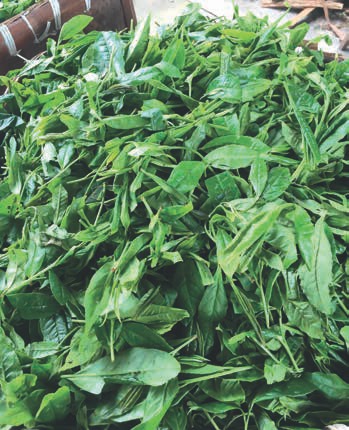
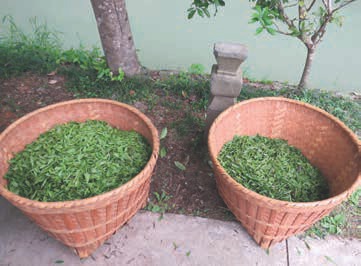
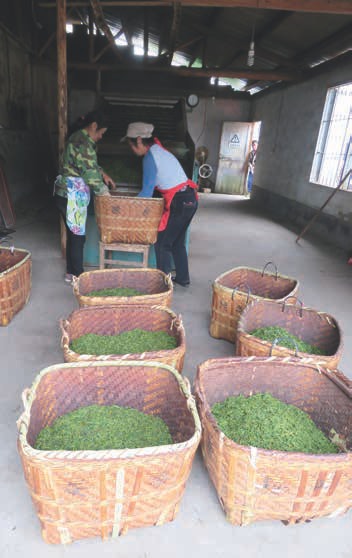
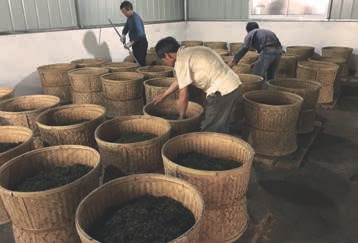
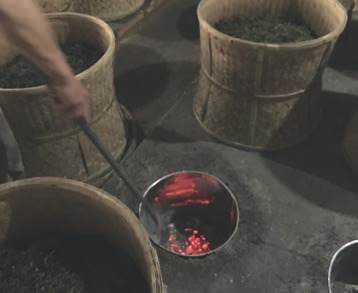



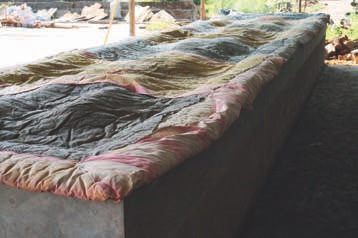
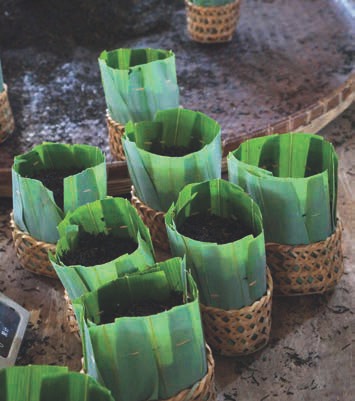
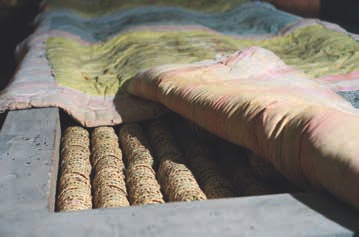
This month's tea is not just unique as a black tea, it is amongst the most amazing of all the extraordinary teas we have ever sent out in Global Tea Hut! Recently, we shared some "Heavenly Basket" black tea from Hunan with our guests and asked them what kind of tea they thought it was. Most guessed oolong. This month's tea would probably have elicited similar answers - it tastes roasted, sweet and the liquor looks golden. Most of us are used to the dark, thick and rich liquor of an aged Liu Bao when we think of black tea. But many black tea producers are making lighter teas these days, as the cost to warehouse teas like this month's for three years is too high. And consumers often want to age the tea themselves anyway. It is hard to say if really qualifies as a black tea. It would perhaps be more accurate to say that it is a green tea processed using some similar processing methods as black tea.
Liu An tea is made from the same raw material as Mao Feng green tea. Traditionally, the first flush would be used for green tea and the second flush for Liu An. The trees this tea comes from are all forty to seventy years old. Also, all the teas on this farm are seed-propagated, which is extremely rare these days, especially for China. The leaves are used to produce green tea, red tea and Liu An tea. Golden Thread was processed by hand, which also makes it a very special tea for this age. There is truly nothing like it in the world!
There is a great magic in knowing that this amazing tea took almost a year to make, and that it was left outside on the fullest moon of the year (the Harvest Moon) and allowed to ferment in the "white dew." While the tea has mellowed since September, it could really use a couple more years of aging to deepen the seal. When we drink this tea, we can feel the moon in each sip. The softness of the dew brings a sweetness that fills the mouth and coats the throat.
Golden Thread is bright and leads you to the poetic, in William Blake's sense of the term: an invitation to adventure. This tea is magic; it's made with fairy dew, after all! There is no other way to describe the experience. When you sit with this tea for an hour or two, the day changes - it glows and the threads lead you beyond your ordinary experience. There aren't any teas that stand as a point of comparison for this one. It is delicate, yet thrumming, sweet with hints of astringency and roast, and very Yin, pronouncedly so. There is a lot of mystery in its flavor, aroma and the way it makes you feel. We have never tried a tea like this before!
When you drink Golden Thread, you can also taste the bamboo basket it was dried in, adding to the leaves and dew in a rich bouquet of flavors. Traditionally, Chinese people would add a piece of the bamboo leaves used to wrap Liu An tea into the liquor they were steeping, or often boiling, usually near the end so they could taste the tea first. We are also going to include a bamboo leaf in each and every tin. You can add it to the tea after you have steeped it a few times, so you can taste the tea by itself first. What happens when you add the leaf at the end? Does it change the flavor? The energy? Let us know on the discussion board of the Global Tea Hut website!
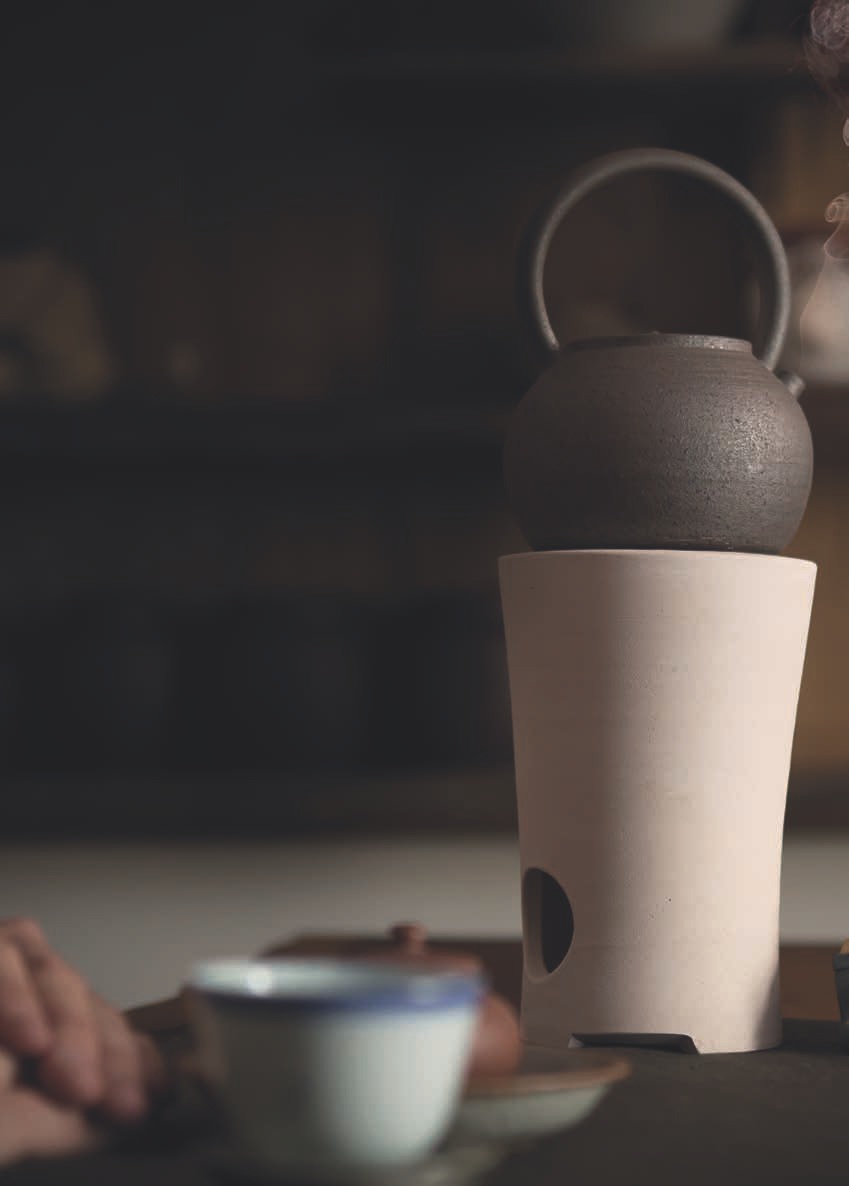
This month's tea should ideally be brewed gongfu, so let's break out our cups and pots and steep this one together. If you don't have gongfu teaware, or don't feel ready to brew tea that way, then you can also steep this tea in a sidehandle pot. If you absolutely have to, you could drink this month's tea in a bowl, but that is less than ideal. This is a tea that longs to be steeped in a pot.
Use some spring water and charcoal, if available. The deeper the heat, the better for a tea like this. And since heat is always so important with a black tea, practice showering the pot both before and after steeping. A good tip is to make sure that you stay off the lid during the pre-shower, rotating in a ring around the upper part of the pot's body. If you shower the lid in the initial shower, it will often be too hot to pick up in order to steep the tea. Then, in the after-shower, you can thoroughly cover the lid. Also, make the after-shower as thorough as you can, completely drenching the pot in steaming hot water. This will increase the depth, smoothness and flavor of your tea, and will increase the patience of the session, which means you will get many more steepings.
Sometimes people ask if it is a waste of water to shower the pot so often, since this brewing method goes through much more water than so-called "dry brewing," in which you don't ever shower the pot. But water is the "Mother of Tea," and is there to serve the finest cup of tea possible. It is never a waste to enhance the tea. The water is here to serve the tea, in other words - much like we are. Anything that makes a finer cup is worthwhile. It isn't a waste of water to shower any more than it is a waste of charcoal to heat the kettle, because all of the elements are here to produce the best cup of tea possible, and therefore fulfill themselves in achieving that end; it is their Dao.
